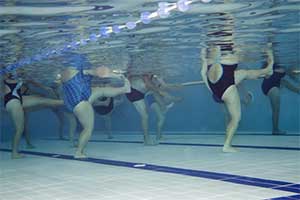Intensive aquatic resistance training decreases body fat mass and improves physcial function in women with mild knee osteoarthritis
Aquatic resistance training significantly decreases body fat mass and increases walking speed, i.e., physical function in postmenopausal women with mild knee osteoarthritis. The effect of aquatic resistance training on walking speed are long lasting and are maintained one-year after training is ceased. However, higher overall levels of leisure time physical activity are required for long-term management of fat and body mass. This was observed in the study carried out in the Faculty of Sport and Health Sciences at the University of Jyväskylä, Finland.
 This study investigated the effect of a 4-month intensive aquatic resistance training program as well as the association between overall leisure time physical activity on body composition and functional capacity in post-menopausal women with mild knee OA. This study was conducted in cooperation with the Central Finland Central Hospital, the Department of Medical Technology, Institute of Biomedicine in University of Oulu, Finland and the Department of Orthopaedics and Traumatology in University of Helsinki, Finland.
This study investigated the effect of a 4-month intensive aquatic resistance training program as well as the association between overall leisure time physical activity on body composition and functional capacity in post-menopausal women with mild knee OA. This study was conducted in cooperation with the Central Finland Central Hospital, the Department of Medical Technology, Institute of Biomedicine in University of Oulu, Finland and the Department of Orthopaedics and Traumatology in University of Helsinki, Finland.
Eighty-seven 60 to 68 years old eligible postmenopausal women with knee pain and confirmed radiographic osteoarthritis related changes in the knee joint were enrolled into the study and randomly assigned into either a training group or a control group. The participants in the training group completed 1-hour of intensive aquatic lower limb resistance exercises three times a week for 4-months. The control group maintained usual care and were asked to continue their usual leisure time activities. Eighty-four women continued into the 12-month follow-up period. Daily physical leisure time activity was recorded throughout the whole 16-month study period.
People with mild knee OA should consider participating in high intensity aquatic resistance training in order to slow or even stop the progression of their knee OA. Higher levels of daily leisure time physical activity was only associated with reduced body weight therefore the high intensity aquatic exercise was essential for improvements in both functional capacity and body composition reported Dr. Ben Waller.
Aquatic exercise for prevention of knee OA
Treatment of knee osteoarthritis is shifting focus from end stage treatment to preventing the progression from early to the late stage of the disease, with the specific aim of decreasing the need for joint replacement and other costly treatments. Two main risk factors for the progression and worsening of pain and decreased in function capacity are increased body mass, in particular fat mass and slower walking speeds. Exercise on land is known to have a positive effect on body composition and walking speed but often people with knee OA avoid physical activity due to pain, even in the early stage of the disease. Therefore, aquatic resistance training appears be an alternative training modality for this population.
The clinical significance of this study is, that the decrease in body mass and increase in walking speed achieved safely with aquatic resistance training are both large enough to prevention worsening of clinical symptoms and slow or even stop the loss of cartilage which are typical finding in late-stage knee osteoarthritis.
Source: University of Jyväskylä
Full bibliographic information:
Effects of high intensity resistance aquatic training on body composition and walking speed in women with mild knee osteoarthritis: a 4-month RCT with 12-month follow-up. Osteoarthritis Cartilage. 2017 Mar 2.

